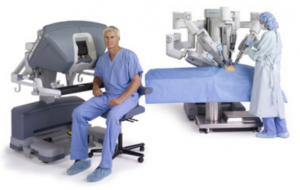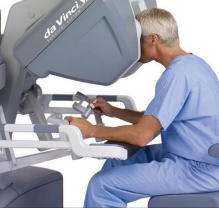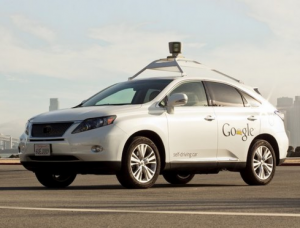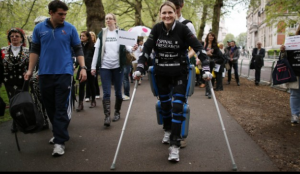Eight weeks ago I walked into a San Diego, CA hospital to undergo elective surgery to repair two leaky valves in my otherwise healthy heart. My leaky heart valves were discovered following a 2012 ski trip, where the high altitude alerted me to breathing challenges that couldn’t be shrugged off as “just being out of shape.”  Searching the web for causes and solutions, I discovered the relatively new medical practice of robot-augmented cardiac valve surgery using a machine named Da Vinci, after Leonardo Da Vinci’s 1495 invention of the first robot.
Searching the web for causes and solutions, I discovered the relatively new medical practice of robot-augmented cardiac valve surgery using a machine named Da Vinci, after Leonardo Da Vinci’s 1495 invention of the first robot.
Da Vinci is a two-million dollar machine designed to facilitate complex surgery with minimal invasion. Since being approved by the U.S. Food and Drug Administration in 2000, Da Vinci robots have augmented over one-million surgery procedures.  When used for cardiac valve repair, Da Vinci’s four pencil thin arms are placed into the heart through the rib cage, above a deflated lung, without opening the sternum (rib cage). Using an internal high definition camera to feed video over to displays at the control station, the surgeon precisely guides Da Vinci’s arms and tiny tool heads within the space of a heart chamber.
When used for cardiac valve repair, Da Vinci’s four pencil thin arms are placed into the heart through the rib cage, above a deflated lung, without opening the sternum (rib cage). Using an internal high definition camera to feed video over to displays at the control station, the surgeon precisely guides Da Vinci’s arms and tiny tool heads within the space of a heart chamber.  Still required is the heart-lung machine to feed oxygenated blood to the body, while the heart is stopped during the surgery.
Still required is the heart-lung machine to feed oxygenated blood to the body, while the heart is stopped during the surgery.
The advantage of minimally invasive Da Vinci surgery is shorter recovery time, less blood loss (in my case no transfusions), and less ancillary complications. Former Navy thoracic surgeon, James Hemp, and his Da Vinci team repaired my mitral valve, and as a surprise benefit closed three unknown birth defect holes in the wall between the left and right chambers of my heart. A doppler ultrasound instrument, placed close to my heart during the procedure, helped locate the holes, verified that the mitral valve was repaired, and verified that the tricuspid valve did not need repair.
As tribute to Dr. Hemp and his Da Vinci team, four days after entering the hospital I literally walked out to resume normal life with a much improved heart. After returning home, despite sore incisions and the need for extra rest, I was immediately able to do almost everything I normally do including work and home projects. In effect, the only real down-time I experienced was the three days I spent recovering in the hospital. Two weeks later, during my first follow-up visit, Dr. Hemp pronounced me fully released to do any normal activity with no prescribed medications. In short, I am an active participant in a modern medical miracle!
Were it not for the emerging symbiotic relationship between man and our modern machines, such a miracle would not have been possible. And this is just the beginning of our human future. Just as smart phones are rapidly becoming “must have” parts of our productive work/private life experiences, many other symbiotic man-machine relationships are emerging. Consider for example:
- Seventy percent of U.S. households now have broadband
- U.S. smartphone usage has climbed to 61% of mobile subscribers
- Nissan Motor Corp. …ready to sell cars capable of fully autonomous driving by 2020
- Anthropomorphic Robotic Tools
Each of these examples represent man-machine relationships that are part of our collective future. Particularly promising will be the anthropomorphic robotic devices capable of augmenting normal human functions for lost limbs or paralysis, and for increasing our human capacity to accomplish superhuman feats. Just as we have learned from our smart phones, upside advantages are always accompanied by unintended negative consequences such as texting while driving.
 The technologies to support self driving cars are currently making rapid progress. Every major auto manufacturer, facilitated by national government organizations including the U.S. Department of Transportation, are working on standards, technology, and the policies needed to enable self-driving vehicles. Google self-driving research cars have autonomously driven over 300,000 miles on U.S. streets and highways. Google is now sufficiently confident in their cars to allow car-team employees to ride the cars on their daily commute.
The technologies to support self driving cars are currently making rapid progress. Every major auto manufacturer, facilitated by national government organizations including the U.S. Department of Transportation, are working on standards, technology, and the policies needed to enable self-driving vehicles. Google self-driving research cars have autonomously driven over 300,000 miles on U.S. streets and highways. Google is now sufficiently confident in their cars to allow car-team employees to ride the cars on their daily commute.
As we continue down these paths no one will be able to fully predict the life changing advantages and associated unintended consequences that await. What we do know is that the evolution of man plus machine is happening much faster than the evolution of either man or machine. I personally am sincerely thankful that Dr. Hemp and his Da Vinci team, have given me a stronger heart to help me explore this exciting future.
Next stop, car robots that deliver us wherever we want, whenever we desire…


Marv,
First, congratulations on a great recovery. Glad to hear all is well. Truly amazing stuff. I find it fascinating that the technologies we saw “imagined” on Star Trek have now come to pass in our everyday lives.
David, yep and wait until we get those pencil sized scanner/repair devices:)
Marv,
The technology used in your procedure is amazing. Thanks for the insight. It also goes without saying that underneath all of that technology is the fact that they stopped your heart, worked on it, and you came back safe to us. That is the most important thing to us.
Let’s hope the terrible twins of Litigation and Liability don’t hold up the self-driving cars too long.
Marv,
Truly remarkable. Expert systems, new materials, robotic applications all seem to be maturing at a rapid pace!
Best wishes
Kurt
Marv
First, congratulations on your successful surgery and recovery; all our best for continued enjoyment of your new-found robustness. Second. Your blog raises an important area of emerging importance: as we find more and more “man-machine” interfaces having bio/bionic construct, our natural tendency is, I think, to accept their benefit as benign at worst, and transformatively positive–like vaccination and transplant surgery: hard to imagine where the down side is. But the embedded requirement of an often complete physical–including genomic–surrender (“I’m putting myself in YOUR hands, doc !”)–in order to become a beneficiary of these treatment modalities is placing pressure on medical ethicists that I believe is outstripping the scope and detail of the dialogue, including dialogue with experts on privacy and security, and butting up against issues like the diminishing bases for assessment of biological attributes of identity (producing the absurd demands from the pharmaceutical industry to patent individual genomes…And who is going to get the “ticket” in the “self driving” car ?). I think as the bionic technology advances, we have to be cautious about the potential of it being two steps ahead of our thoughtful policy analysis, and three steps ahead of the legislatures…We DO have the technology…can we get the POLICY it demands ?
Michael, I agree that policy and laws are behind as per normal. Even in my own procedure the pre-tests I went through provided a full body check up just to have my heart repaired. The cars won’t get tickets because they will be programmed to obey traffic laws so that they can drive closer together to improve traffic flow… just like Da Vinci won’t let the doctors do jerky damaging movements with the robot arms…
Marv, glad to hear you are back to being a full “up” round. I thought you might like to see this interview with a fellow from a company here in San Diego, 5D Robotics. They are emerging as national leaders in unmanned ground systems, starting with military application and rapidly moving to the commercial world. The link can be found here: Watch “David Bruemmer Interviewed on UT-TV” by 5D Robotics: http://vimeo.com/58998243 . Best regards, Dan
Excellent blog, Marv, and good to hear the procedure went so well. Michael’s observations are perceptive, I think. Policy considerations really are needed regarding medical technology, particularly in the United States where the advances are rapid and often wonderful, but where the medical system’s focus on pay for services, among other things, drives access to the technological benefits narrowly to those who can afford them.
Jim, from what I know our insurance and medicare system allow medical procedures that are far more expensive and high tech than other socialized medical systems. In Britain one has to buy a private medical insurance to obtain the expensive procedures late in life.
Marv,
Good news story. Just in time for the re-release of the 6 Million Dollar Man. I expect Ray Kurzweil will be commenting shortly and is probably jealous. Looking forward to many more Blog entries from you. Don’t forget the daily red wine prophylactic.
I am way ahead on the daily red wine:)
It’s a huge advantage to live in the 21st century. Most people of moderate means possess things and exploit services not available to even the richest people on Earth 100 years ago.
Enjoy your comparative riches and richness!
amen! even our less fortunate people live with more luxury than earlier Kings. But the medical procedures will become even more a have/have-not differentiator…
Dear Marv,
Great news on your successful operation. Brings the term man-machine interface to a whole new level. This is particularly good news for my family – we have a member with intraventricular septal defect. Perhaps this regimen will be helpful for us.
I look forward to seeing you, hale and hearty, at ONI soon. Very best regards.
Mike
Man-machine issues besides, facing potential life changing health problems focuses the mind and immediately crystalizes what is important and what isn’t. Post surgery, perhaps the concept of “post tramatic growth” should be in ones lexicon as a way of gaining additional insight to the fragility of life.
Glad you are back in “the fight”.
Bob,I don’t think our society has even begun to understand the rapid lifespan growth we are heading into. People already take medical vacations to buy low cost exotic procedures. Maybe it should be post traumatic growth…
Marv – Great article. Congratulations on your swift recovery and another step towards the Singularity.